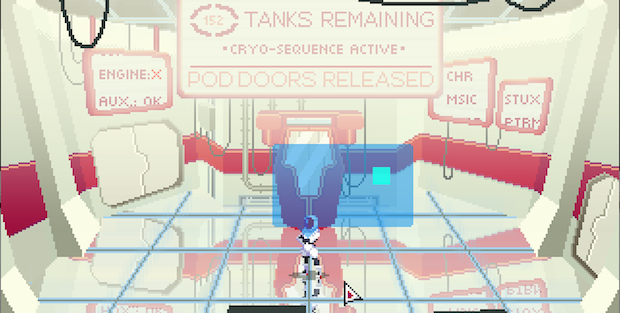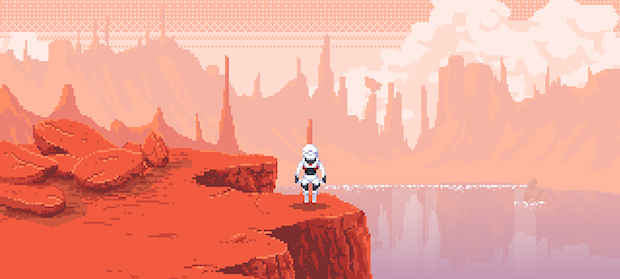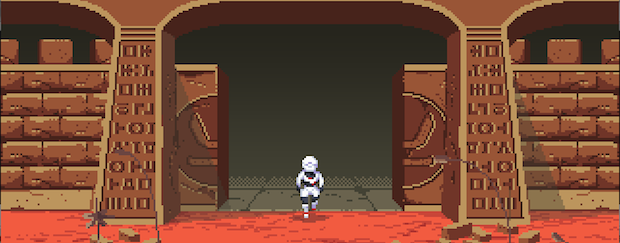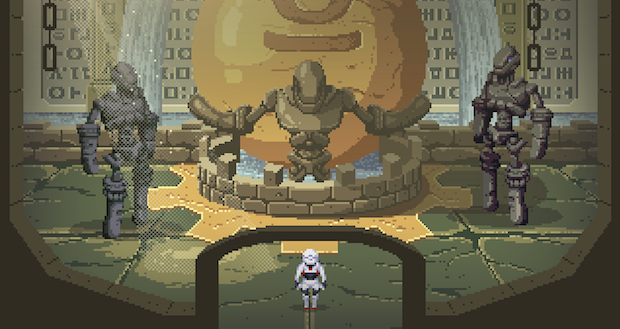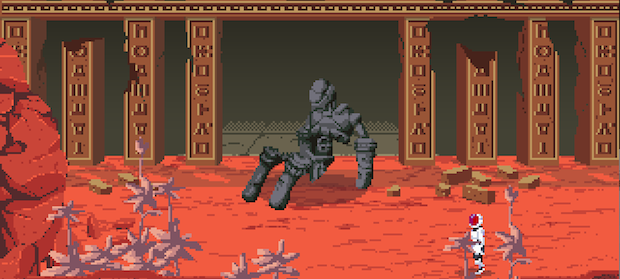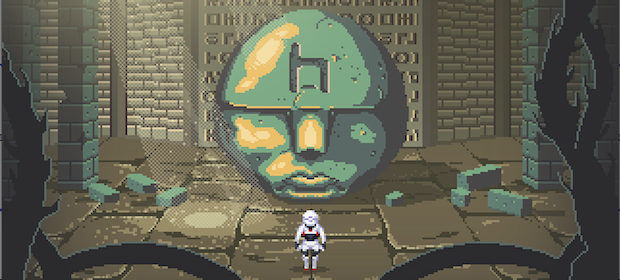Hands-On: Stranded
Stanley Kubrick’s mind
Sometimes, I want to go off-world. I look up at constellations and think that there might be, out there somewhere, the remnants of our imagination. A planet full of the wondrous things that we dream of: a race of noble cyborgs, canyons and canyons of undisturbed blue rock, stalactites of green fragile crystallations, or perhaps somewhere it rains neon yellow. Perhaps our kin might one day crash-land on that undisturbed planet and make all our grimy chores and overcast skies, even our trips to the moon, seem insignificant. This planet of wonders drifts somewhere in space, turning itself over with care.
I’ve been wanting to talk to you about Peter Moorhead’s new project, the exploration-based adventure game Stranded, for a long time. Its little preview build puttered into my inbox a few weeks ago, and crash-landed in my head. It sits there lodged now, like an adventure game lens into Stanley Kubrick’s mind.
Yes, there’s this game that exists in my mind, and it’s a version of The Dig. Do you remember The Dig? Perhaps you played it at the formative age I did, or a little older. It was a Lucasarts adventure game about three astronauts going into space to investigate an asteroid called ‘Attila’. It was based on an idea by serial imaginationist Steven Spielberg, and written by disgraced man of Ender’s Game, Orson Scott Card. Robert Patrick voiced the main character. It was polished for an adventure game - and it wasn’t the wacky humoured thing I was used to. It was more about exploration and puzzles than Full Throttle, the game it was bundled with. The Dig was visually beautiful: it was a series of exotic off-world landscapes accompanied by the sustain of a string orchestra, something that indicated wonderment, awe. But as I look at the game now, this is not the game that ten year old me played. My mind has warped it. No, in my head, The Dig much more closely resembles Stranded.
Listen to this music.
You begin by opening the pod doors. A little spacewoman exits the cryo-freeze and stands in a white spacesuit. She is breathing her first breaths in a long time; you can tell because the breaths are heavy, slow, loud. She is animated to have her whole body take those breaths. I take the right hand door.
Outside, I am by a cliff edge. I go to the edge and observe a far-off regal bipedal stonebeast walk towards the lake behind me. It is walking slowly into the lake, and as I stand there, it submerges, and then floats to the surface. Have I just witnessed a suicide? Part of me thinks it is too beautiful here for suicide. I cross back through my spaceship and exit to the left. There is the smouldering wreck of my spaceship. And just to the edge of the screen, I notice a giant leave. I follow.
You click on the ground to navigate. The navigation and pathfinding in the build I'm playing is a little janky, but the walking pace seems deliberately slow. You may click on the astronaut to reveal a little LCD map of where you have visited. Peter describes it as the ‘Proteus’ of adventure games, and I think I understand as I traverse screen to screen, landscape to landscape. Each new place I find is a place which cannot be interacted with; it’s just a vignette in my mind, a series of wonderfully animated places breathing in rhythm with my spacegirl. This is The Dig of my memories: I cannot remember words or puzzles, I only remember what it is like to witness beautiful, exotic planetscapes and hear the music of wonder.
At some point, you will come across the Shrine. Here two of the stone cyborgs stand, breathing in time with you, a shaft of light shining gently on the shrine floor. In the middle, the statue of a cyborg holding up the planet. You cannot interact with anything here. You may only look on and listen to the music.
These silent giants only look on. You sometimes know they are trying to lead you places; to what is unclear now. Part of you suspects that you might not make it off this planet. But another part of me suspects I was fated to crash here, fated to help.
Peter tells me that the exploration of this place does eventually lead to a direct goal, but the build I was given only showed select screens on the map that I could see. “It's intended to capture the atmosphere of games like The Dig, the quieter moments of Metroid Prime, and other such titles,” he says.
The feeling of nostalgia for the adventure games I played as a child is strong here, but importantly, does not reflect any adventure game I have yet played. Stranded’s ability to depict movement, exploration, and travel to stunning alien places is something I loved. Walking slowly from screen to screen is more of a contemplation, a wide-eyed feeling of seeing something for the first time. That feeling of the first time you thought you knew what videogames could do for you: the feeling that you were now allowed to go to the stars without ever leaving your chair. I’m looking forward to going back.
Stranded will be released on Windows, Mac and Linux in early 2014, but keep an eye on Peter's website.


